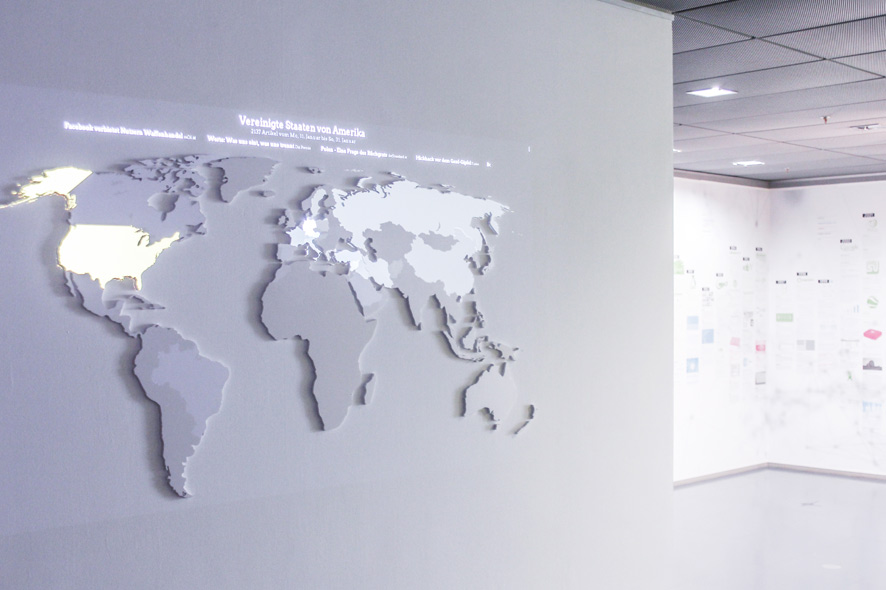TIME OUT is an ongoing series of exhibitions staged jointly by Linz Art University’s Time-based and Interactive Media program and the Ars Electronica Center. The co-curators are Gerhard Funk, the director of this program of study, and Gerfried Stocker, Ars Electronica artistic director. Selected students get the opportunity to show their work at the AEC and to present it themselves at the opening.
One of the students whose works are being showcased in Time Out.05 is Benedikt Reiter. His project entitled “[inter]national coverage” deals with how Austria-based online media outlets report on internationally relevant news stories. To do it, data from the previous 24 hours are evaluated and projected onto a relief-type map of the Earth. This mode of depiction makes it immediately apparent which areas of the world Austrian reportage is focusing on—which countries are making headlines nationwide and, conversely, which areas are being neglected by the media. The installation includes a touchscreen visitors can use to select individual states and access a news timeline.
We recently interviewed Benedikt Reiter about his project and the current state of international news coverage by Austrian media.

Credit: Martin Hieslmair
How did you come up with the idea of graphically depicting the international news coverage in Austrian media?
Benedikt Reiter: Most people believe that our media give equal coverage to all current events worldwide. But when you delve more deeply into this issue, you quickly realize that it’s not the case. Media are, on one hand, purveyors of the news but they’re also news filters. Accordingly, there’s little or no coverage of countries that are purportedly of lesser interest to people in our society. Take, for example, the earthquake in Nepal in April 2015. Here, due to the nature of the catastrophe, there was a brief spike in reportage in Austrian media, but news about this country appeared relatively seldom in the media before the quake and afterwards.
In my project, this is demonstrated via a graphic mode of depiction, which shows both the short-term spikes as well as the areas of the world that our coverage concentrates on for the most part.
What countries do Austrian journalists focus on? Are there countries that get absolutely no coverage at all?
Benedikt Reiter: At present, of course, there’s intensive reporting on ISIS in Syria and the resulting flow of refugees through the Balkans. Previously, these countries were comparatively marginal as far as coverage was concerned. And even though the Iron Curtain fell decades ago, its virtual persistence is often still evident in my graphically depicted data. Whereas there’s coverage of Western states several times a day, the frequency of reporting declines significantly the further eastward you go. Of course, the focus is clearly on the global economic powers; on the other hand, the number of news stories about African countries is negligible.
To what do you think this is attributable, the fact that there’s more written about some countries than others?
Benedikt Reiter: Of course, the editors of a media outlet have to make choices about what to publish from among countless reports filed every day. These editorial decisions are very strongly oriented on the readership. Publications that aim to be sources of quality journalism provide much more wide-ranging coverage than the tabloids. Furthermore, many readers are interested only in what directly affects their lives. An article about a civil war in a country that many readers might not ever have even heard of has a good chance of being dismissed as irrelevant.

Credit: Martin Hieslmair
If you were to expand your project and analyze the international coverage in other Western countries, do you think you’d find the same countries appearing as frequently or as rarely as they do in reporting in Austrian media?
Benedikt Reiter: That’s very hard to say. Of course, many parallels can be drawn here but I certainly wouldn’t lump them all together. The media landscape in particular differs from country to country. In Germany, for instance, satirizing the news had developed much further than it has in Austria, and I consider this a very welcome development since the use of satire often lets you reach people who otherwise wouldn’t pay much attention at all to the particular issue. Needless to say, though, this can turn out to be a complete flop sometimes too [laughs].
When you scrutinize the visualization on the world map, have you ever come across something that’s really surprised you, or have you generally gotten the results you expected?
Benedikt Reiter: There are days on which there are articles about countries that had rarely if ever received coverage up to that point in my project. Then, my first reaction is always surprise, but ultimately, it usually turns out that the sports section of some site had just published a world ranking list in some sport. That always makes me chuckle a little, since somehow it seems as though the sports page were even more international than the news of the world.
The exhibition “TIME OUT .05” opens at the Ars Electronica Center on Wednesday, March 16, 2016.
